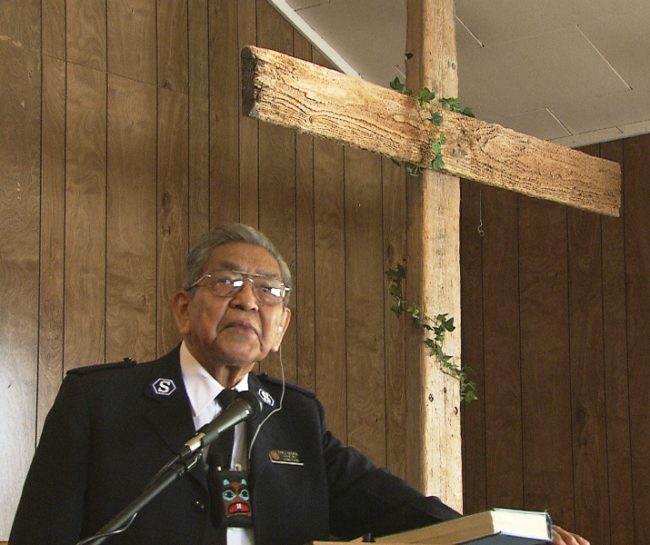
A memorial service for Cyril George Sr. is Wednesday, 6 p.m., at Elizabeth Peratrovich Hall in Juneau. The Tlingit elder died April 15 at the age of 92.
Over his life, he was a fisherman, boat builder, master storyteller, and man of great faith.
George was of the Deisheetan clan (Raven/Beaver) of Angoon and lived in the Admiralty Island community most of his life. He moved to Juneau in 1975.
One of his five sons, Richard George, recalls his father to be a successful seiner, halibut and herring fisherman.
He also served his community. He was elected to the Angoon City Council and was mayor. He was on the first board of directors of Sealaska, the regional Native corporation for Southeast, from 1972 to 1974, and served as a member of the board for Kootsnoowoo Inc., Angoon’s village corporation.
Richard George remembers his father as a strong man.
He made decisions which always seemed to be the proper decision. That’s what I was impressed with when I was young,” he says.
Cyril George attended Sheldon Jackson high school and college in Sitka in the late 1930s, where he became a machinist and learned to build boats. The Presbyterian school was tasked with helping Tlingit shipwright Andrew Hope build the Princeton Hall, a replacement vessel for the church mission fleet.
“I wasn’t the only one that had this feeling of an enormous undertaking when he started to build this boat,” Cyril George recalled in a 2007 interview with KTOO.
“I could weld, I did everything in the machine shop. I was with him all the way from lining up the motor, the shaft, setting up the electrical,” he said. George also built the shaft.
It took a year to complete the Princeton Hall. Then in 1941, just a few days after the Japanese attack on Pearl Harbor, the boat was to be launched. It had already been conscripted by the U.S. Navy.
George said all the Sheldon Jackson students trooped down to the harbor to watch the launch.
“When the Navy started to tow it away all the kids were crying. I was crying. I don’t think there was anybody that wasn’t crying,” he said.
After the war, the Princeton Hall was returned to the Presbyterians and it traveled Southeast Alaska waters for years, going village to village.
While George helped build it, he had never been on the boat. Many years later, he had a number of cruises on the Princeton Hall after it was purchased by the late Bill Ruddy. Bill and Kathy Ruddy became close friends with Cyril George, the boat builder, the musician, and the Tlingit storyteller.
George gradually began to lose his hearing. For several years, Kathy Ruddy took on the role of stenographer – typing out conversations for him.
“It really helped him to have things written down so he could look over your shoulder and know what people were saying,” she says.
The hearing loss didn’t slow him down. He continued to play his guitar and sing, visit classrooms, churches, and be involved in the community. He was a delegate to the Juneau chapter of Central Council of Tlingit and Haida Indian Tribes of Alaska, which provided a transcriber for George, so he could be actively involved.
“You know for a guitarist and a really excellent musician, hearing loss is a really poignant thing,” Ruddy says. “The fact that he maintained this constant sense of gratitude even as hearing was failing is just a tribute to his character.”
As a fluent Tlingit speaker, George liked to teach his language and often went to Tlingit language classes at the University of Alaska Southeast, taught by Lance Twitchell.
“In Tlingit he’d tell us: ‘I just feel wonderful whenever I’m looking upon your faces and you guys are learning your language.’ He said he felt that it (Tlingit language) was drifting away from us but then just seeing us fills him with hope.”
Son Richard George calls his father a Godly man. In the 2007 interview, Cyril George talked about a battle with alcohol, which he said he finally won through prayer and his faith.
He was a member of the Salvation Army and was a local commissioned officer known as a sergeant major. He often wore his uniform and always wore it to church, says Lt. Lance Walters of the Salvation Army in Juneau.
He explained one day that he put it on to remind him of what he came from and that he wasn’t going back,” Walters says.
George will be buried on Killisnoo Island near Angoon.